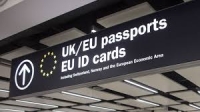New Skills-Based UK Immigration System Will Take Effect From 2021
Friday 28 June, 2019 Written by With thanks to, The South African
Last month, during a performance on “The Tonight Show Starring Jimmy Fallon,” Morrissey wore a pin featuring the logo of the For Britain Movement, a far-right UK political party founded by anti-Islam activist Anne Marie Waters.
Morrissey's argument is that people of a certain race want to live with their own kind - with others equally passionate, about living in a multi-cultural society. Morrissey deny's being a racist...his argument is a familar one to Brexit supporters.

Image: Artist Morrissey's views on immigration are attracting controversy.
Brexit argues supporters will solve our immigration issues by 'taking back control of our borders' as if we had ever lost control some would argue. Immigration has been falling significantly recently but some people have argued that after Brexit immigration could go up?
The UK Government has earlier this month reaffirmed its move to a single, skills-based immigration system. The introduction of the future immigration system will take effect from 2021.
The new immigration system will mark the end of free movement for European workers to the United Kingdom. It will not favour any specific nationality. Europeans will have to compete with all other nationalities if they want to apply for UK jobs and visas.
The end of free movement will also mean that there will be more job opportunities available. This, coupled with a simpler skills-based immigration system, will allow other nationalities to take up more job opportunities in the UK.
Furthermore, there will no longer be a cap on the number of workers that can come in a specific period. This will make it easier for UK employers in specific sectors to hire the number of workers they need.
The UK Government has provided ten reasons why the new immigration system will support both business and jobs
The single, swift immigration system will mean that businesses can hire talent from everywhere in the word.
There will not be a cap on the number of skilled workers coming to the UK. UK employers can thus hire the number of overseas workers that they need.
The skills threshold will be widened so that anyone with the equivalent of A-Levels will be eligible to work in the UK.
The Resident Labour Market Test (explained below) will fall away for highly skilled workers.
The introduction of a digital sponsorship system to relieve the administrative burden on UK employers.
The introduction of a temporary work route for low-risk countries to come and work in the UK at any skill level.
Overseas students will be allowed to stay longer after completion of their studies to look for graduate job positions.
The salary threshold will be lowered for positions where workers are in short supply.
There will be greater flexibility for overseas students to move into the UK labour force.
EU and visitors from low-risk countries will be able to use e-gates at UK ports of entry.
ABC Note: Currently, the specific requirements of the Resident Labour Market Test (‘RLMT’) are set out in the Tier 2 and 5 Guidance for Sponsors (‘Sponsor Guidance’). The aim of the RLMT is to protect the settled workforce by requiring employers to advertise jobs in the UK in order to allow settled workers to apply. The requirements of a RLMT are stringent and if even one of the requirements is overlooked the Home Office can refuse to accept that a RLMT has been carried out in accordance with its requirements.
Resident Labour Market Test and Exemptions
This is what is currently required
The specific requirements of the Resident Labour Market Test (‘RLMT’) are set out in the Tier 2 and 5 Guidance for Sponsors (‘Sponsor Guidance’). The aim of the RLMT is to protect the settled workforce by requiring employers to advertise jobs in the UK in order to allow settled workers to apply. The requirements of a RLMT are stringent and if even one of the requirements is over looked the Home Office can refuse to accept that a RLMT has been carried out in accordance with its requirements.
When to carry out a Resident Labour Market Test (RLMT)
An employer wishing to sponsor a non-EEA national under any of the following categories must ensure they have advertised the role in accordance with the Sponsor Guidance before issuing a certificate of sponsorship:
Tier 2 (General);
Tier 2 (Minister of Religion) or Tier 5 (Religious Workers);
Tier 5 (Creative and Sporting).
Exemptions
However, the Sponsor Guidance sets out a number of exemptions which, if applicable, would mean that an employer does not have to carry out a RLMT before assigning a certificate of sponsorship to a non-EEA national.
For example, an employer wishing to sponsor a non-EEA national under the Tier 2 (General) route of the Points Based System would not have to carry out a RLMT in the following circumstances.
Continuing in the same occupation with the same employer
If the non-EEA national is already working for the company and they wish to extend their leave in the same immigration category in order to continue working in the same occupation.
Shortage of occupation
An employer will not be required to carry out the RLMT where they wish to sponsor a non-EEA national in a role that appears on the Shortage of Occupation List (with the exception of Nurses under SOC code 2231). The Shortage of Occupation List is set out in Appendix K of the Immigration Rules which can be found here and is reviewed regularly by the Migration Advisory Committee (‘MAC’). Roles will be added to the list when evidence has been presented to the MAC which suggests there are not enough settled workers in the UK to fill the jobs available.
Post study work
A RLMT will not be required where the non-EEA national is already in the UK and is applying to switch into Tier 2 (General) from one of the following immigration categories:
Tier 1 (Post-Study Work);
Tier 1 (Graduate Entrepreneur); or
where an individual was last granted leave under Tier 4 or as a student and during that leave they had completed a UK bachelor’s degree, a Postgraduate degree or a minimum of 12 months study in the UK towards a PhD.
High earners
If an employer plans on providing a total salary package of £159,600 or above a RLMT will not be required as the non-EEA national would be classed as a ‘high earner’.
Complete information regarding the exemptions that apply to the RLMT can be found in the Sponsor Guidance and we would recommend that an employer reviews this guidance before assigning a certificate of sponsorship.
How to carry out a RLMT
In order to comply with the requirements of the RLMT the position being recruited for must be advertised in two places for at least 28 calendar days.
The simplest option is for adverts to be placed online. One advert must generally be placed on the Find a Job website whilst the other advert can be placed on a suitable website of the employer’s choosing, providing applicants are not charged to view the advert or apply for the role. It is recommended that an employer uses a website that is normally used by the industry or sector.
Special thanks to the following who organisations whose information has enabled us to complete this article:

Image: Carter Thomas, leading specialist immigration law firm.
Image: Breytenbachs Immigration Consultants ltd
ABC Comments, have your say below:

Leave a comment
Make sure you enter all the required information, indicated by an asterisk (*). HTML code is not allowed.
Join
FREE
Here











